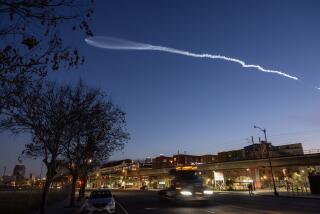Clinton Keeps Puerto Rican Range Closed to Navy
WASHINGTON — President Clinton refused Friday to reopen the Navy’s controversial live-fire training range in Puerto Rico, rebuffing Pentagon arguments that the 58-year-old site is of “irreplaceable” value in preparing the Atlantic Fleet and Marine forces for combat.
Facing solid opposition from local leaders, Clinton said that live-fire training can be resumed only with local assent. He ordered that in any case the Navy must evacuate the range on the small island of Vieques, southeast of San Juan, within five years.
“I understand the long-standing concerns of residents of the island,” Clinton said in a statement.
The move marks a rare occasion in which Clinton has rejected the nearly unanimous recommendations of senior uniformed leaders. Defense officials acknowledged that the sight of U.S. forces withdrawing from an American training site could invite trouble in allied countries, such as Japan, where the sometimes intrusive presence of U.S. forces already is a source of unrest.
The decision is in keeping with the wishes of First Lady Hillary Rodham Clinton, who has called for the Navy to leave the 52-square-mile island. Critics have accused Mrs. Clinton of taking her stand in an effort to woo Puerto Rican voters in her planned U.S. Senate race in New York.
But the president’s action did not fully satisfy Puerto Rican officials, who are unhappy that the Navy will be allowed to use dirt-filled inert bombs beginning next spring to continue training while they search for a new site.
Gov. Pedro Rossello said in a news conference that the move is “unacceptable.” Puerto Rican leaders have demanded that the Navy leave Vieques immediately and pay for an environmental cleanup of the island.
The decision comes after seven months of tense, top-level negotiations, which began after a Marine pilot in an F-18 fighter dropped an errant bomb that killed a security guard on the Vieques training range. The tragedy stirred old unhappiness with the training facility and caused hundreds of protesters to camp out on the site in defiance of the law.
Clinton’s decision means that a Navy aircraft carrier battle group that was scheduled to begin training at Vieques in two weeks instead will leave Norfolk, Va., in February for a European deployment without completing its full sequence of training.
Over the years, the live-fire training grounds and the open waters nearby have given Navy ships and Marine amphibious forces the opportunity to practice complex joint operations involving aerial bombardment, naval artillery practice and Marine landings.
It is the Navy’s only East Coast site for such “integrated” training. On the West Coast, the forces use San Clemente Island off Orange County.
With Vieques unavailable, the carrier Eisenhower battle group will conduct alternate training off the coast of southeastern states, supplemented by additional training at Cape Wrath, Scotland, once it reaches Europe.
Officials said that this “‘work-around” solution will provide a satisfactory level of training. But they said it will not duplicate the quality that the Atlantic Fleet has attained through live-fire training.
Military officials noted that it will be difficult for the Atlantic Fleet to get all the training it needs until a substitute for Vieques is found. Cape Wrath, for example, is battered by weather that is so bad it often makes training impossible.
“As a long-term solution, it’s not a good one,” said Navy Secretary Richard Danzig.
In hopes of winning local permission to use Vieques, the Pentagon is offering an economic development plan funded with an initial $40 million.
The plan calls for the Navy to use the range no more than 90 days each year, down from a current maximum of 180 days. But Puerto Rican leaders said these inducements will not change their determination to evict the Navy from the island.
Pentagon officials sought to remind Puerto Ricans of sacrifices made by the neighbors of all 48 live-fire military training ranges in the United States.
“All U.S. citizens . . . must make some sacrifices in order to support the strong national defense,” Secretary of Defense William S. Cohen said in a statement. “There is not some single part of our country that doesn’t make some adjustments or accommodation to sustain the presence of the military.”
Yet defense officials acknowledged that it will be very difficult to change public opinion in Puerto Rico.
The planned withdrawal is another example of how military training operations have been curtailed in recent years by pressures from civilian neighbors and environmental concerns--including in Southern California.
The Army’s plan to add 331,000 acres to its National Training Center at Ft. Irwin, for example, has been put on hold because of environmental concerns. Marines at Camp Pendleton have had to give up flying space to commercial air traffic, while troops at Twentynine Palms have seen acreage put off limits because of concerns about an endangered desert tortoise.
Clinton’s decision drew angry fire from some congressional Republican leaders.
Sen. John W. Warner (R-Va.), the moderate chairman of the Senate Armed Service Committee, said that the move “will mark the first time in our nation’s over 200-year history that America and its territories have knowingly turned their backs on the responsibility to properly and fully train those who go forth in harm’s way to protect our national interest.”
More to Read
Sign up for Essential California
The most important California stories and recommendations in your inbox every morning.
You may occasionally receive promotional content from the Los Angeles Times.











